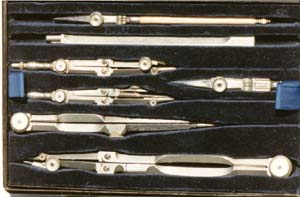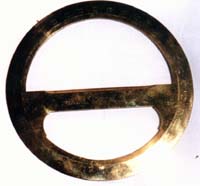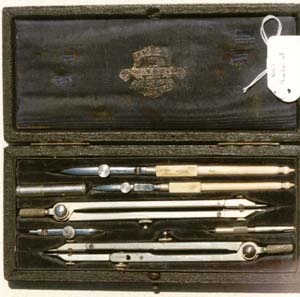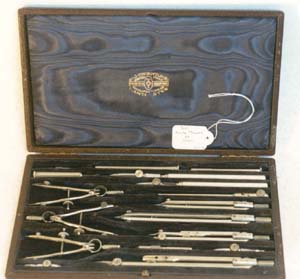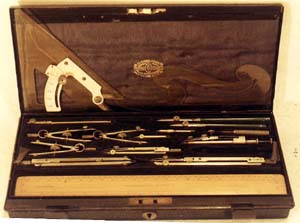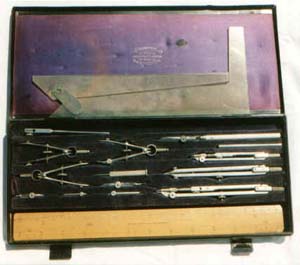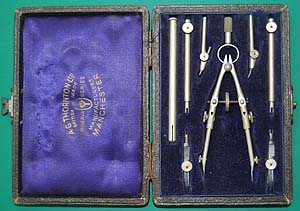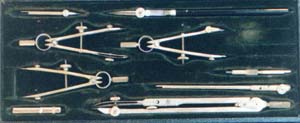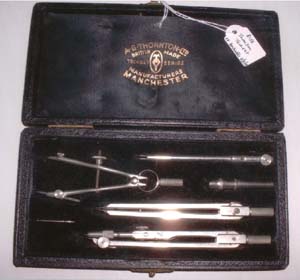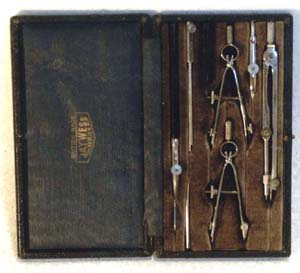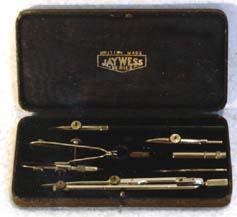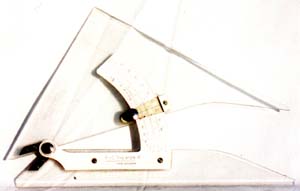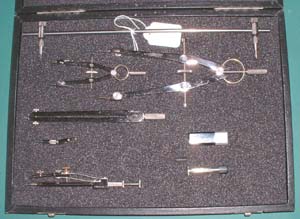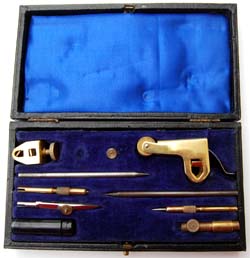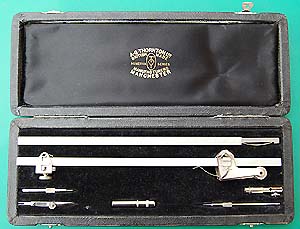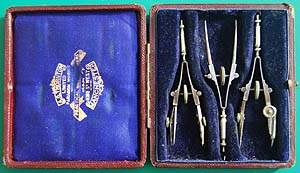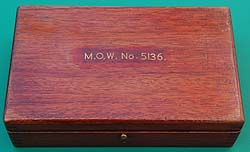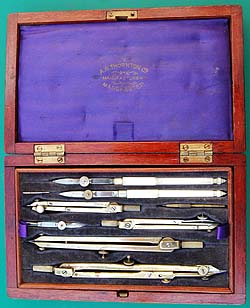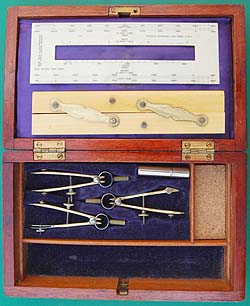











Founded in 1880 at 109 Deansgate, Manchester by Alexander George Thornton, the firm grew to become one of the largest manufacturers of drawing instruments and slide rules in Britain. The Precision Instrument Co was taken over in 1901 and PIC continued to be used by Thornton as a trade mark until about 1970. The firm became British Thornton in 1967 and merged with ESF at Burley in 1992. British Thornton is now a manufacturer of school furniture in Keighley.


A traditional pattern set of electrum instruments by A G Thornton dating from the late nineteenth century.
The instruments were purchased loose and I adapted an empty steel case to take them by making a set of velvet lined pockets to fit the instrument tray of the case in the same way as they would have originally been made.
A six inch circular protractor by Thornton of Manchester. This copper alloy protractor is probably gun metal but could be brass. About 1900.
A "British Empire" pattern set, dated 1939, made for H M Government.
This pattern of instruments was basically that “approved by the Inter-Departmental Committee appointed to consider the design of British drawing instruments” (ref: Casella catalogue no. 564 p173). They were made with minor variations by several British manufacturers.
A "Minerva Series" set in a large 'pocket' case. Thornton introduced the Minerva series prior to 1916 (they appear in the catalogue for that year) and continued making them until, at least, the 1950s. One of the instruments is date stamped for 1942.
The section Miscellanea (Who Made Them) features a Halden Premier set in which the metal instruments are of the Minerva series pattern. It is highly probable that Thornton made the electrum instruments for the Halden Premier sets.
The Minerva series compasses and dividers were copies of
E O Richter’s flat system that A G Thornton had sold prior to the First World War.
A Thornton Minerva set in a tropical case. Besides the usual instruments the tray contains a drop bow compass.
The bottom of the case contains celluloid curves, a protractor and a Thornton Kinwest six-inch adjustable set square.
Dates from 1934 according to the date stamp on the pen bow compass.
Another Thornton Minerva set in a tropical case. This one includes a celluloid clinograph. Dates from 1946 according to date stamp on a compass.
Thornton Minerva insert spring bow set. The four inch spring bow can be lengthened to six inches by fitting the two extension bars. It has two each of pen, pencil lead and divider needle point inserts and there is also a pen handle. Mid-20th century.
Thornton Techset instruments in a wallet case. The Techset series were a cheaper version for students, based closely on the Minerva series.
A small case of Techset instruments. The compass and dividers are smaller size instruments. Dates from 1955.
The Jaywess series of instruments, made by Thornton, were their cheapest range, aimed at technical schools. Dates from 1946.
A small Jaywess set. The turnabout spring bow did not feature in their more expensive sets but was common in Jaywess ones. Dates from 1937.
This eight inch "Thornton PIC" adjustable set square was purchased by me as a student in 1963 and the transparent part is acrylic. It is still in use when a square is needed.
A set of British Thornton instruments dating from about 1970. It includes large and small spring bows, a beam compass, dividers and a drop bow (or rotating) compass. The instruments are housed in plastic foam (which has been replaced as the original had perished to dust) instead of velvet lined pockets. The instruments would probably have been selected and then the appropriate size case purchased to house them.
VC7983 Compasses, Beam, 26” T.P. (Thornton Pattern) B8025. Roller beam compass, presumably by A G Thornton, patent number 155970/19. A set of beam compass fittings made for the WD in the mid twentieth century. Brass and steel. One of the long steel points would be clamped to one end of the beam by the smaller fitting (top left). The larger fitting (top right) has a spring at one end and a roller at the other. The insert holder (bottom right) fits into this fitting and either the pen, pencil or needle point insert can be fitted in this.
This type of beam compass (but nickel silver) is shown in the 1930 B J Hall catalogue where it is described as “Gill’s Patent no. 155970/19”.
Thornton Minerva beam compass. This is the same type of beam compass as the one above but has a plated finish and a two section, rectangular Aluminium tube, beam that is 18.5” long when assembled. It probably dates from the 1950s. The case is lined with black silk & velvet.
Set of electrum and steel spring bows, probably Edwardian. Unusually they have hexagonal handles and centre thumb wheels. The pen & pencil bows are fitted with Thornton’s Improved Nut & Bolt points (Rd. No. 354,874), whilst the divider bow has plain points. Morocco covered, blue silk & velvet lined case.
Ministry of Works set no. 5136 made by A G Thornton in 1945. The instruments are based on the Techset series but are made brass rather than electrum. The pen handles are ivorine, as is the Protractor Rectangular 6 inch Ivorine A Mk IV. The parallel rule is boxwood. This set is of a type made by several manufacturers to what appears to be a government specification.





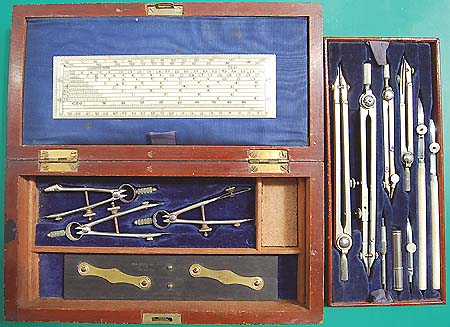
British Empire pattern set made for the British government in 1938. Oddly, not all the instruments are signed Thornton. The large compass, dividers, bow compasses and parallel rule are marked Harling and the protractor is by GH Cooper and dated 1936. The pens are unsigned. There could be a number of reasons for this. This set is higher quality than the MOW set above.
B J Hall Simplex set of drawing instruments dating from the 1930s and catalogued by B J Hall as D 321. It was in fact made by A G Thornton and is identical to their Minerva set E9511 / F9511. The larger ruling pen has been broken and the handle shortened at some time. The beam compass fittings are Gill’s patent.
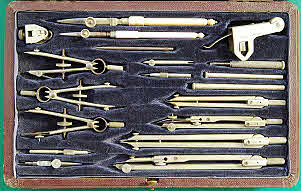
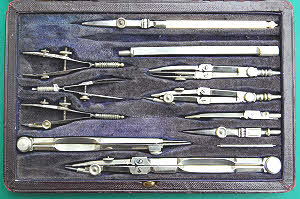
Thornton traditional pattern full set in a Morocco case. It is missing one ruling pen and one spring bow is incorrect.
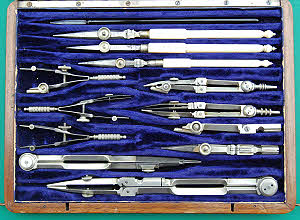
Another traditional pattern set by Thornton; this one is in a polished wood, pin-lock case and higher quality than the one above. The two smaller ruling pens are replacements, as is the agate pointed tracer. It is missing a fine line pen, pricker and compass extension bar. Thornton was at St Mary St, Deansgate, Manchester from 1897-1904.
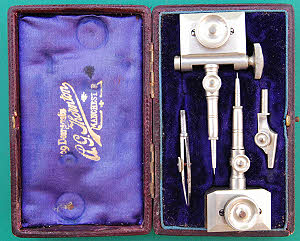
A set of Swiss pattern beam compass fittings signed A G Thornton 109 Deansgate, Manchester. The points are the screw-off type.
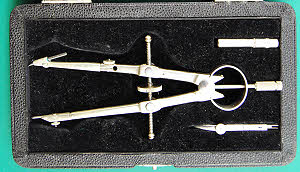
A Thornton Minerva six inch spring bow or master bow compass dating from the 1950s probably
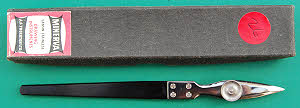
Thornton Minerva detail pen MS81 again probably dating from the 1950s

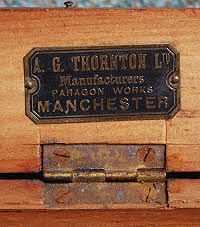
A complete set of twenty lancewood splines by A G Thornton. These were used with special weights to draw long curves, particularly by ship designers and naval architects. Many of the splines are tapered so that the curve would vary in radius along its length as the spline thickness, and hence its stiffness varied. There are five 5 foot, five 4 foot, six 3 foot and four 2 foot splines in this set. I’m now looking for the weights that would have been sold separately.
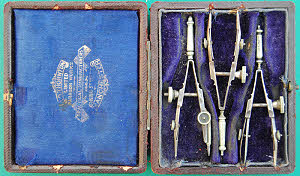
Like the set of Thornton spring bows in an earlier picture, these have hexagonal handles but these have side adjusting wheels and have ordinary nut and bolt needle points. Morocco covered, blue silk and velvet lined case. One electrum handle has ‘patent’ on it and the other two are stamped ‘Thornton’
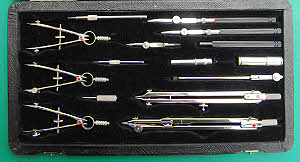
Ca. 1960 Thornton Minerva set of electrum & stainless steel instruments. The pens have plastic handles. The compass and divider have ball bearing, self-centring head joints for which Thornton obtained a patent (GB684,850) in 1952 (applied for in 1950). The pricker is an original addition to the set, which is in pristine condition.
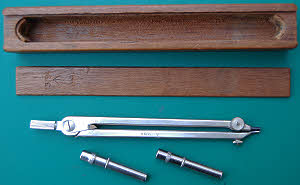
Pencil compass made by Thornton for the UK government marked with the broad arrow and 13/94 (both compass and case marked) and dated 1956. The set, to a government specification, comprised the compass and separate containers for leads and needles. The head is the ball bearing type but not self-centring. I believe these compasses were originally intended for aircraft navigation and were made by a number of makers, especially in WWII. I have a 1942 example by Aston & Mander. Each maker had their own design.
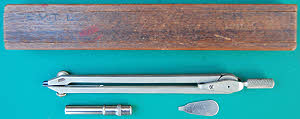
A 1940 Thornton pencil compass and wood box, both dated 1940 with the Air Ministry logo. This compass has the “Techset” type of head. Another of these Air Ministry compasses in my collection was made by WEDOCO in 1942.
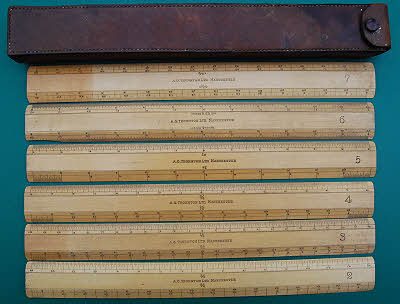
Set of six 10”, single-sided, scales by A G Thornton numbered 2 to 7 (there was probably a number 1 as well originally) in a leather case. Scales 2 to 5 are unusual as they have a centre zero one edge and a zero inset by the finely divided first and last increments on the other (open divided) side, which is left and right reading. They are for 3/8, 1/2, 3/4, and inch. Scale 6 is inches x 50ths and scale 7 is cms. Thornton offered a very wide range of scales with several different forms of dividing and would also divide scales specially to customer’s requirements.
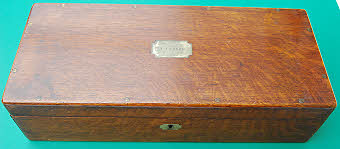
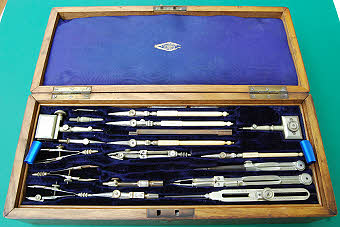
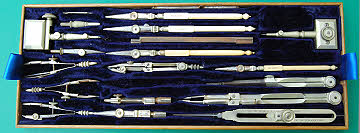
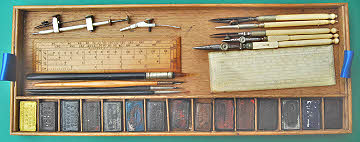
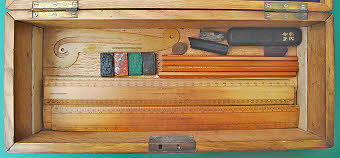
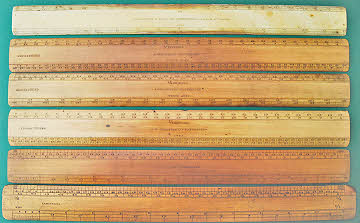
A 14” polished oak case of traditional English pattern drawing instruments by A G Thornton, 109 Deansgate, Manchester dating from ca.1890 The spring bows and six-inch compass have screw-off points and the latter was made by W H Harling as probably were the spring bows. At this date Alexander George Thornton did not make all of the instruments he sold and some were certainly bought in, so I am pretty certain these were all original to the set. The 1883 W H Harling catalogue lists these screw off points as Harling’s Improved Needle Points and they are found on sets by Harling, Thornton and Halden from this period. In every case the spring bows have the same 3 knurled rings on the handle and were undoubtedly made by Harling, again see the 1883 Harling catalogue. The pens in the top tray are all signed Thornton and one is Thornton’s Self-Filling Drawing Pen designed by A M Low Esq, registered no. 522051. Since it was registered in 1908, about ten years after Thornton left 109 Deansgate, this must be a later addition or replacement. In the lower tray are four further pens (one signed Stanley) and a pricker with Harling’s improved needle point. It is likely that this pricker is original to the set as may be one of the other pens. Another interesting item is the drop bow compass as it is an early example of E O Richter’s patented design that Thornton imported and illustrated in his 1895 catalogue. It may well have been purchased with the set as the items in the second tray and base were optional, such as the set of water colours, mostly by Geo Rowney & Co, included in this case. This would also have applied to the ivory protractor, in this case a 5” one that is unsigned but again dates from when this set was purchased. The boxwood 6” rectangular protractor is by Rowney so could also be original or an early addition. In the base are six scale rules. Four are by Thornton but, interestingly, two have the same scales and one is an Armstrong scale, the other three being chain scales. There is a second, unsigned Armstrong scale and an ivory scale signed J Archbutt & Sons. These must have been added at some time after the set was first purchased although the ivory scale is probably older than the set and is in rather poor condition. There are also four un-used 4H & 5H pencils in the base - typical drafting pencils made by A W Faber. When purchased there were also a number of other instruments and parts that are now in my spares boxes.
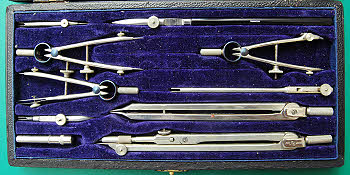
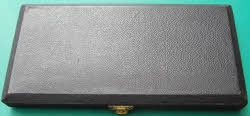
A 1947 Thornton Techset. Whilst still basically to the same design as the pre-war version with which the inserts are still interchangeable, there is one important difference. The head design of the compass and divider has been changed. Note also that the C springs and pivots of the spring bows are now brilliantly blued steel. Since the set was given to me I have cosmetically restored the case using matt black enamel paint on the bare patches, followed up when thoroughly dry by polishing with black shoe polish.
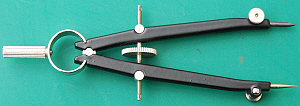
British Thornton pencil spring bow, late 20th century. 4.4 inches long,
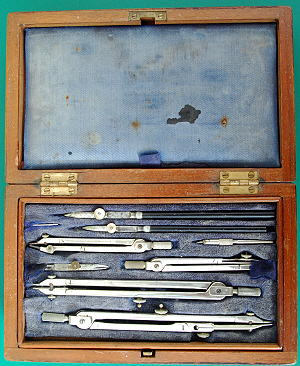
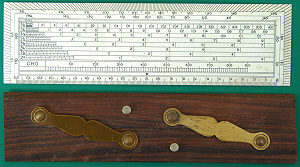
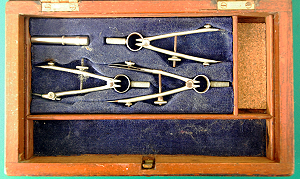
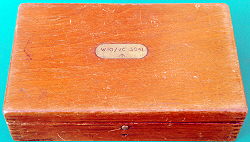
Thornton W10/VC 5841 set made for the British military in 1951. It is basically the
same as the MOW set seen earlier but the instruments are now electrum (brass was
used for the MOW set as a wartime economy measure). Although based on the Techset
series the needle mounts in the compasses and divider are the type used on the British
Empire series. The pens are not original although they are Thornton.
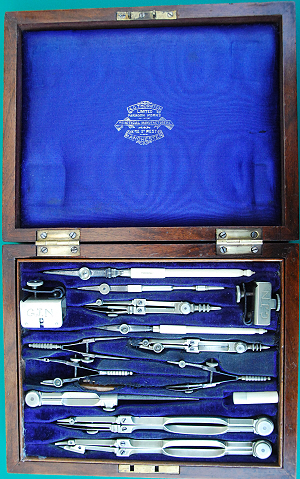
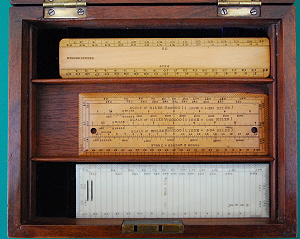


This extended full set features a Thornton speciality, separate ink and pencil compasses.
Because these do not have a lengthening bar the set also has beam compass fittings.
These are the Richter type and almost certainly made by E O Richter in Germany. Since
Thornton did not import these after the start of WWI and they have the revised spring
arrangement introduced not long before WWI the set can be quite confidently dated
to the years preceding WWI. As was usual with British sets at this time the choice
of scales, protractors etc was left to the purchaser. They were not part of the set.
In this case there are an unsigned boxwood chain scale, a boxwood Protractor 6” x
2” Exactly signed Hugh Rees Ltd, London & Aldershot, and an ivory sketching protractor
of unusual design signed Army & Navy CSL. Since the two protractors are both normally
associated with the army it is possible that the original owner was a military gentleman
although I suspect the ivory protractor is older than the set and so may not be original
to it.
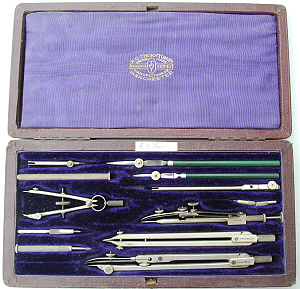
Thornton Minerva set with drop bow compass dating from ca.1930.
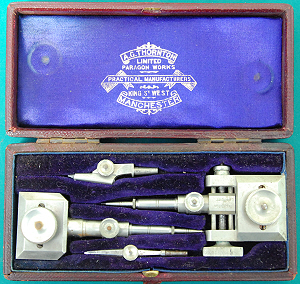

Thornton’s Improved Rigid Beam Compass (Patent). This particular example has screw
off needle points like the Ordinary Pattern example further up this page. Catalogue
number D6879½ in the 1916 catalogue.





